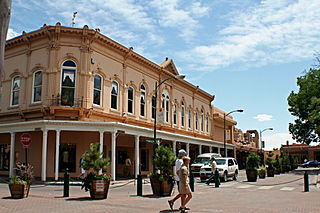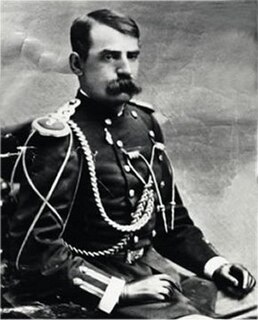
The Basilica of Our Lady of Guadalupe is a Roman Catholic church, basilica, and National shrine of Mexico in the north of Mexico City which houses the cloak containing the image of Our Lady of Guadalupe. The 1709 shrine was built near the hill of Tepeyac, where the Virgin Mary is believed to have appeared to Saint Juan Diego Cuauhtlatoatzin. The basilica structure which now contains Diego's cloak was completed in 1974.

The Roman Catholic Archdiocese of Santa Fe is an ecclesiastical territory or diocese of the southwestern region of the United States in the state of New Mexico. While the mother church, the Cathedral Basilica of Saint Francis of Assisi, is in the city of Santa Fe, its administrative center is in the city of Albuquerque. The Diocese comprises the counties of Rio Arriba, Taos, Colfax, Union, Mora, Harding, Los Alamos, Sandoval, Santa Fe, San Miguel, Quay, Bernalillo, Valencia, Socorro, Torrance, Guadalupe, De Baca, Roosevelt, and Curry. The current archbishop is John Charles Wester, who was installed on June 4, 2015. The Archdiocese announced it would file for bankruptcy protection on November 29, 2018.

The Spanish Missions in New Mexico were a series of religious outposts in the Province of Santa Fe de Nuevo México — present day New Mexico. They were established by Franciscan friars under charter from the monarchs of the Spanish Empire and the government of the Viceroyalty of New Spain in a policy called Reductions to facilitate the conversion of Native Americans—Indians into Christianity.
Mission Nuestra Señora de la Asunción de Zia was a Spanish Mission in the area that is now New Mexico. It was established in 1706.

San Felipe de Neri Church is a historic Catholic church located on the north side of Old Town Plaza in Albuquerque, New Mexico. Built in 1793, it is one of the oldest surviving buildings in the city and the only building in Old Town proven to date to the Spanish colonial period. The church is listed on the New Mexico State Register of Cultural Properties and the National Register of Historic Places and has remained in continuous use for over 200 years.

The Cathedral Basilica of Saint Francis of Assisi, commonly known as Saint Francis Cathedral, is a Roman Catholic cathedral in downtown Santa Fe, New Mexico. It is the mother church of the Archdiocese of Santa Fe.
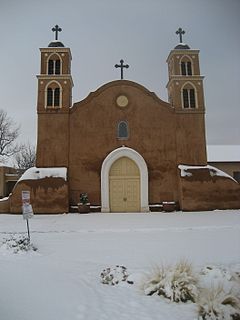
San Miguel de Socorro is the Catholic church in Socorro, New Mexico, built on the ruins of the old Nuestra Señora de Socorro mission. The old mission was built around 1626, but was destroyed in 1680 during the Pueblo Revolt. A portion of the adobe wall of the old church remains today and still can be seen behind glass just left of the altar. The building was listed on the National Register of Historic Places in 2016.
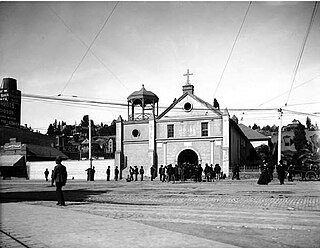
La Iglesia de Nuestra Señora la Reina de los Ángeles,, is a historic Roman Catholic church in El Pueblo de los Ángeles Historical Monument in northern downtown Los Angeles, California, United States. The church was founded by the Spanish in the early 19th century when modern-day California was under Spanish rule and known as Alta California in the Viceroyalty of New Spain.

The Basilica of Guadalupe or Santuario de Nuestra Señora de Guadalupe, has a fifty five gold crowns inside. is a Roman Catholic church located in the metropolitan area of Monterrey, Nuevo León, Mexico. Standing in the neighborhood of Colonia Independencia, just outside the city's downtown area, the temple is one of the larger Church edifices in northern Mexico. It is dedicated to Virgin Mary in her guise as Our Lady of Guadalupe, the Patroness of America, who appeared to St Juan Diego on Tepeyac Hill outside Mexico City in 1531.

The Mission Nuestra Señora de los Ángeles de Porciúncula was a mission that served the people of the Pecos Pueblo, near modern Pecos, New Mexico, from sometime around 1619.

The original Franciscan mission, Nuestra Señora de la Concepción del Socorro, was founded in 1682 by the Franciscan order, to serve displaced Spaniard families, American Indians from New Mexico, who fled the central New Mexico region during the Pueblo Revolt. The present Socorro Mission was constructed around 1840 to replace an earlier 18th-century mission destroyed in 1829 by flooding of the Rio Grande. The mission, constructed of adobe surfaced with stucco, is particularly notable for its interior. The finely painted and decorated beams, or vigas, are from the 18th-century mission and were reused when the present church was constructed. The massing, details and use of decorative elements of the Socorro Mission show strong relationships to the building traditions of 17th-century Spanish New Mexico.

The Ysleta Mission, located in the Ysleta del Sur Pueblo within the municipality of El Paso, Texas, is recognized as the oldest continuously operated parish in the State of Texas. The Ysleta community is also recognized as the oldest in Texas and claims to have the oldest continuously cultivated plot of land in the United States.

Nuestra Senora de Luz Church and Cemetery is a historic church building 13 miles southeast of Santa Fe, north of Interstate 25 frontage road in Canoncito, New Mexico.
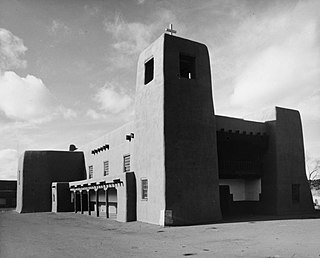
The Reredos of Our Lady of Light is a historic stone reredos carved in 1761 in Santa Fe, New Mexico. It was originally installed in the Chapel of Our Lady of Light on the Plaza and is presently housed in Cristo Rey Church, which was built for that purpose in 1940. Described as "the only one of its kind from the Spanish period in the United States" and "definitely one of the most extraordinary pieces of ecclesiastical art in the country", it was added to the National Register of Historic Places in 1970.

La Morada de Nuestra Senora de Guadalupe, also known as Taos Morada, is a holy site and past home of La Fraternidad Piadosa de Nuestro Padre Jesús Nazareno in Taos, New Mexico. The Penitent Brothers, or the Hermanos Penitentes used the Morado for religious study of ancient Catholic lay religious practices.

Our Lady of Guadalupe Parish or Nuestra Senora de Guadalupe is located just west of the Taos Plaza at 205 Don Fernando Street in downtown Taos, New Mexico.

The Our Lady of Guadalupe Cathedral Also Ciudad Juárez Cathedral Is the name of a Catholic cathedral church dedicated to the Virgin of Guadalupe, that is located in Ciudad Juárez in the border state of Chihuahua, in Mexico, in the area called Historical Center. It was built in the middle of the second half of the twentieth century and is attached to the old and still preserved Franciscan mission, founded in the 17th century, in the then Paso del Norte.
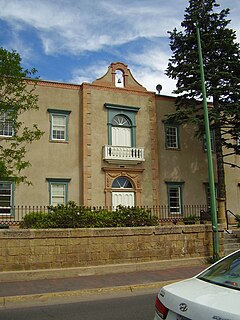
The Lamy Building, also known as St. Michael's Dormitory, is a historic building in Santa Fe, New Mexico. It was built in 1878 as the main building of St. Michael's College, the predecessor of St. Michael's High School and the College of Santa Fe. The building is a contributing property in the Barrio De Analco Historic District and currently serves as the headquarters of the New Mexico Tourism Department.

Cristo Rey Church is a Roman Catholic parish church on Canyon Road in Santa Fe, New Mexico. It is one of the most notable buildings designed by influential Santa Fe architect John Gaw Meem and is claimed by some sources to be the largest adobe building in the United States. It is also notable for its historic altar screen, the Reredos of Our Lady of Light, which is listed on the National Register of Historic Places. The reredos was carved in 1761 and originally hung in La Castrense, a military chapel on the Santa Fe Plaza. It has been described as "one of the most extraordinary pieces of ecclesiastical art in the country". The church was dedicated in 1940.
